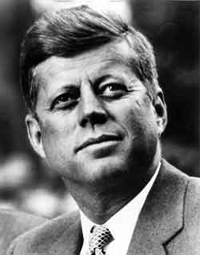
Source: John F. Kennedy, White House photo portrait, looking up, White House Press Office, Wikimedia
Syntax is “the arrangement and sequence of words in sentences, phrases, and clauses.” OK, but what does that mean? It means that syntax is the way words are combined to create phrases, clauses, and sentences. Syntax varies in different cultures and languages. In Spanish, for example, adjectives often follow the nouns they modify, but in English adjectives usually precede the nouns they modify.
Understanding how authors and speakers use syntax to control the meaning and tone of their work will help you grow stronger as a reader and writer. Careful selection and arrangement of words is one of the most powerful tools in an author’s toolbox. To see an example, let’s read the words of a young president who was trying to inspire a nation that faced an uncertain future.
In the long history of the world, only a few generations have been granted the role of defending freedom in its hour of maximum danger. I do not shrink from this responsibility—I welcome it. I do not believe that any of us would exchange places with any other people or any other generation. The energy, the faith, the devotion which we bring to this endeavor will light our country and all who serve it—and the glow from that fire can truly light the world.
And so, my fellow Americans: Ask not what your country can do for you—ask what you can do for your country.
What are your initial reactions to this segment of President Kennedy’s speech? Does it inspire you? Can you feel his words reaching into your heart? His syntax is what makes this speech so effective. In fact, the way JFK ordered his words inspired a generation. These words gave hope to people and lifted their hearts. This illustrates the power of syntax and what can happen when the best words are placed in the best order.
Notice how effectively President Kennedy uses references to himself when he says “I do not shrink from this responsibility” and goes on to say “I welcome it.” Then he begins the next sentence with, “I do not believe . . .” Repetition of the phrase “I do not” is used to capture the audience’s attention and reinforce important points.
President Kennedy also uses effective parallel structure to give his speech power and clarity. He is saying, in a sense, that he’s in charge, and we are secure under his watch. Look at how he encourages his audience to use their faith, energy, and devotion (three nouns parallel in importance) to “light a fire” that will “light the world.” The “light” phrases are metaphors for how people can inspire one another (like a chain reaction) to defend freedom and by defending it, become an example to other nations.
One of JFK’s most quoted statements is “Ask not what your country can do for you—ask what you can do for your country.” This famous quotation uses a rhetorical device called chiasmus.
Notice how the parallel structure has been reversed in this sentence. In the second part of the statement, President Kennedy challenges us to do the opposite of what he asks us to do in the first part. Because of the syntax or word order, this statement catches your attention and might make you feel a little guilty. It may even inspire you to get involved in your community or become a volunteer!
 Try this exercise to see the power of syntax. Using your notes, write down the lyrics from your favorite song. Remember, syntax involves the arrangement of words or phrases. How do the words make you feel? If the words were in a different order, would they still have the same effect? Rearrange them to find out. When you're finished, check your understanding to see a sample response.
Try this exercise to see the power of syntax. Using your notes, write down the lyrics from your favorite song. Remember, syntax involves the arrangement of words or phrases. How do the words make you feel? If the words were in a different order, would they still have the same effect? Rearrange them to find out. When you're finished, check your understanding to see a sample response. Original
Blackbird singing in the dead of night
Take these broken wings and learn to fly
All your life
You were only waiting for this moment to arise
Rearranged Syntax
In the dead of night singing blackbird
These broken wings take and learn to fly
Your life
All for this moment you were only waiting to arise
Songwriters: John Lennon/PaulMcCartney
While the second version sort of works, the first is more elegant and lyrical.
All writers and speakers choose their words and the way they arrange them to make their work more powerful. You will see in the next section that poets in particular use surprising and unusual syntax to make reading poetry a unique experience.